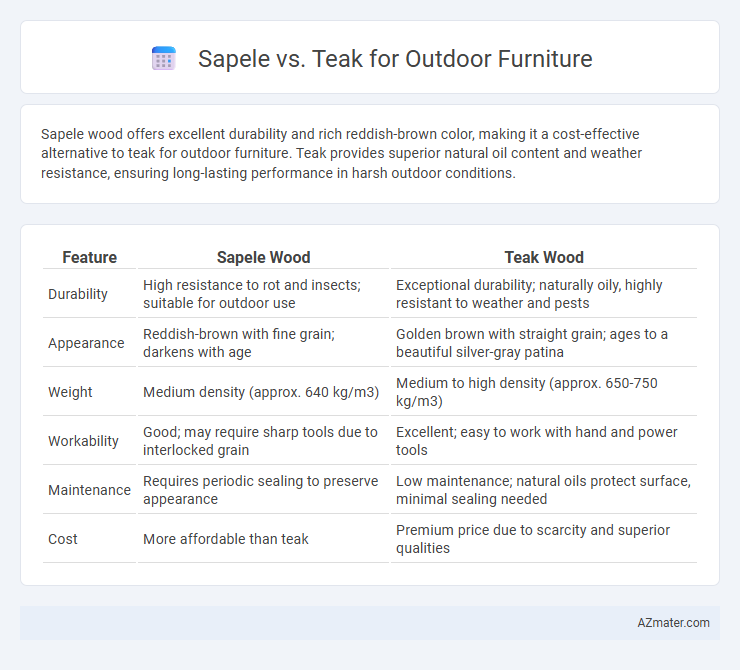Sapele wood offers excellent durability and rich reddish-brown color, making it a cost-effective alternative to teak for outdoor furniture. Teak provides superior natural oil content and weather resistance, ensuring long-lasting performance in harsh outdoor conditions.
Table of Comparison
| Feature | Sapele Wood | Teak Wood |
|---|---|---|
| Durability | High resistance to rot and insects; suitable for outdoor use | Exceptional durability; naturally oily, highly resistant to weather and pests |
| Appearance | Reddish-brown with fine grain; darkens with age | Golden brown with straight grain; ages to a beautiful silver-gray patina |
| Weight | Medium density (approx. 640 kg/m3) | Medium to high density (approx. 650-750 kg/m3) |
| Workability | Good; may require sharp tools due to interlocked grain | Excellent; easy to work with hand and power tools |
| Maintenance | Requires periodic sealing to preserve appearance | Low maintenance; natural oils protect surface, minimal sealing needed |
| Cost | More affordable than teak | Premium price due to scarcity and superior qualities |
Introduction: Sapele vs Teak for Outdoor Furniture
Sapele and teak are popular hardwoods widely used in outdoor furniture due to their durability and resistance to weather conditions. Sapele offers a rich reddish-brown hue with fine interlocking grain, providing strength and natural resistance to decay, making it suitable for harsh outdoor environments. Teak, renowned for its high oil content and dense fiber structure, delivers exceptional water resistance and longevity, often lasting decades with minimal maintenance.
Overview of Sapele Wood
Sapele wood, native to tropical Africa, is a highly durable hardwood prized for outdoor furniture due to its resistance to rot, insect damage, and weathering. Its fine interlocking grain provides a smooth finish with a rich reddish-brown hue that darkens over time, enhancing aesthetic appeal. Compared to teak, Sapele offers a cost-effective alternative while maintaining durability and natural resistance essential for long-lasting outdoor use.
Overview of Teak Wood
Teak wood is prized for outdoor furniture due to its exceptional durability, natural resistance to water, insects, and decay, and rich golden-brown color that deepens over time. Its high oil content ensures minimal maintenance and excellent weather resistance, making it ideal for garden sets, benches, and patio furniture. Teak's dense grain structure provides strength and longevity, often lasting several decades even in harsh outdoor conditions.
Durability and Weather Resistance Comparison
Sapele offers solid durability with excellent resistance to rot and decay, making it suitable for outdoor furniture exposed to moderate weather conditions. Teak surpasses Sapele in weather resistance due to its natural oils that repel water, insects, and prevent warping, ensuring longevity even in harsh climates. While both woods are hardwoods, teak's superior durability and minimal maintenance requirements make it the preferred choice for outdoor applications.
Maintenance Requirements
Sapele requires less frequent maintenance than teak, with occasional cleaning and annual oiling sufficient to preserve its rich, reddish-brown hue. Teak's high natural oil content makes it resistant to weathering and pests but demands regular oiling every few months to prevent surface oxidation and maintain its golden color. Both woods benefit from periodic sealing to extend their lifespan and maintain structural integrity in outdoor environments.
Appearance and Aesthetic Differences
Sapele wood features a rich reddish-brown color with a fine, interlocking grain that produces a lustrous, ribbon-like effect, enhancing its visual appeal for outdoor furniture. Teak showcases a warm golden to medium brown hue that darkens with age, characterized by straight grains and natural oiliness, which contribute to a sleek, classic aesthetic. The contrasting grain patterns and color tones of Sapele and Teak influence the overall style, with Sapele offering a more decorative, exotic look while Teak delivers a timeless, elegant appearance.
Cost and Availability
Sapele wood offers a more affordable option compared to teak, making it attractive for budget-conscious outdoor furniture buyers. While teak is renowned for its durability and natural oils that resist weathering, its higher cost and limited availability can restrict accessibility. Sapele, sourced primarily from West Africa, remains readily available and provides a cost-effective alternative without significant compromise on quality or aesthetic appeal.
Environmental Sustainability
Sapele and teak both offer durable options for outdoor furniture, but teak is more sustainable due to its slower growth in managed plantations, ensuring responsible harvesting practices. Sapele, a member of the mahogany family, often faces higher deforestation risks because it is less commonly cultivated and more frequently harvested from natural forests. Choosing FSC-certified teak supports environmental sustainability by promoting forest conservation and reducing habitat destruction.
Best Use Cases for Sapele and Teak
Sapele wood is ideal for outdoor furniture in humid climates due to its natural resistance to moisture, decay, and fungal attacks, making it perfect for garden benches and patio sets exposed to frequent rain. Teak excels in coastal or salty environments because of its high oil content and dense grain, which provide superior durability and resistance to saltwater corrosion, suitable for poolside loungers and marine-grade furniture. Both woods age beautifully with exposure, but teak requires less maintenance over time, making it the preferred choice for long-term outdoor investment pieces.
Conclusion: Which Wood is Right for Your Outdoor Furniture?
Sapele offers excellent durability, natural resistance to rot and insects, and a rich reddish-brown hue making it ideal for outdoor furniture exposed to moderate weather conditions. Teak, with its superior oil content and exceptional weather resistance, stands out for longevity and minimal maintenance in harsh outdoor environments. Choosing between Sapele and Teak depends on budget, desired appearance, and climate exposure, with Teak being the premium option for long-lasting performance and Sapele providing a cost-effective, attractive alternative.

Infographic: Sapele vs Teak for Outdoor Furniture
 azmater.com
azmater.com